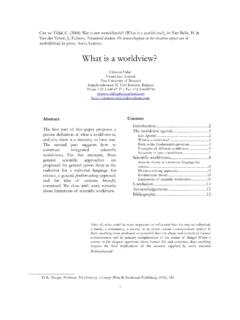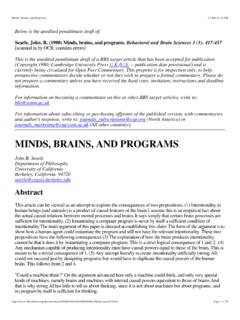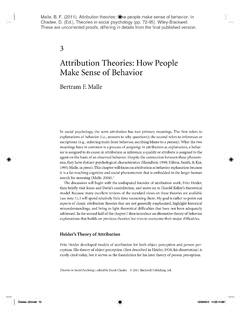Transcription of Attributions as Behavior Explanations: Toward a New Theory
1 Unpublished manuscript, University of Oregon, 2003. Copyright by Bertram F. MalleAttributions as Behavior Explanations: Toward a New TheoryBertram F. Malle, University of OregonAttribution Theory has played a major role in social-psychological research. Unfortunately,the term attribution is ambiguous. According to one meaning, forming an attribution ismaking a dispositional (trait) inference from Behavior ; according to another meaning,forming an attribution is giving an explanation (especially of Behavior ). The focus of thispaper is on the latter phenomenon of Behavior explanations.
2 In particular, I discuss a newtheory of explanation that provides an alternative to classic attribution Theory as it dominatesthe textbooks and handbooks which is typically as a version of Kelley s (1967) model ofattribution as covariation detection. I begin with a brief critique of this Theory and, out of thiscritique, develop a list of requirements that an improved Theory has to meet. I then introducethe new Theory , report empirical data in its support, and apply it to a number of psychologicalphenomena. I finally conclude with an assessment of how much progress we have made inunderstanding Behavior explanations and what has yet to be Theory is a core element of social-psychological thinking.
3 Thousands of articles havebeen published in 40 years of research, and textbook and handbooks of social psychologytypically devote a chapter or large section to attribution phenomena. This body of research,however, can be distinguished into a general approach to social-psychological phenomena an attributional analysis, as Bernard Weiner has called it and theories of specific attributionphenomena, such as Kelley s (1967) Theory of explanation or Jones and Davis (1965) Theory ofdispositional inference. The general attributional approach recognizes that humans try to makesense of their surroundings and themselves and that this sense-making activity (explanations,finding meaning, creating stories) is an integral part of the social phenomena under approach has made countless contributions to the literature, shedding light on achievementmotivation, responsibility judgments, helplessness, sleeplessness, obesity, depression, emotion,and well-being research ( , Abramson, Seligman, & Teasdale, 1978.)
4 Jones, Kanouse, Kelley,Nisbett, Valins, & Weiner, 1972; Schwarz, & Clore, 1983; Weiner, 1995), and it has become acentral part of social psychology as a theories, by contrast, are theories of more specific attribution , the term attribution is quite ambiguous. According to one common meaning,forming an attribution is giving an explanation (especially of Behavior ); according to anothercommon meaning, forming an attribution is making a dispositional (trait) inference frombehavior (Hamilton, 1998; Hilton, Smith, & Kin, 1995; Malle, 2004). Even though explanationsand trait inferences are occasionally related, they are distinct in many ways.
5 For example,explanations sometimes refer to traits but often do not; trait inferences can be explanatory butusually are not; traits can be inferred from any Behavior , whereas explanations are triggered only2 Bertram F. Malleby surprising or confusing Behavior ; explanations are answers to why questions, trait inferencesare focus in this chapter is the phenomenon of Behavior In particular, Idiscuss a new Theory of explanation that provides an alternative to classic attribution Theory as itdominates the textbooks and handbooks which is typically as a version of Kelley s (1967)model of attribution as covariation detection.
6 I begin with a brief critique of this Theory and, outof this critique, develop a list of requirements that an improved Theory has to meet. I thenintroduce the new Theory , report empirical data in its support, and apply it to a number ofpsychological phenomena. I finally conclude with an assessment of how much progress we havemade in understanding Behavior explanations and what has yet to be attribution TheoryKelley s (1967) original Theory and many others after him (Cheng & Novick, 1990;Fiedler, Walther, & Nickel, 1999; F rsterling, 1989; Hewstone & Jaspars, 1987) made twocore claims:(PS)The causal concepts on which people rely when forming behaviorexplanations consist of a dichotomy of internal vs.
7 External (or person ) causes.(COV)The cognitive process that underlies explanations is covariation we examine each of these core claims of attribution Theory in turn, we see thatthere is shockingly little support for either. First, what is the empirical evidence for claim (PS)?In most attribution studies, the truth of (PS) was assumed, not tested. Participants had to fill outscales for person/disposition and situation causes ( , Storms, 1973) or researchersclassified free-response explanations into person and situation categories ( , McGill, 1989;Nisbett, Caputo, Legant, & Marecek, 1973).
8 In neither case was assumption (PS) few attribution studies that did not automatically make the person-situation assumptionfound several other dimensions of explanation to be of greater importance than that of personand situation ( , Fletcher, 1983; Lewis, 1995; Passer, Kelley, & Michela, 1978). Likewise,substantial research in developmental psychology, which did not make the person-situationassumption, found no evidence for the truth of (PS). The data show that even 3-4 year oldchildren distinguish between intentional and unintentional Behavior and explain the latter byreferring to the agent s beliefs and desires he or she had for acting ( , Bartsch & Wellman,1989; Wellman et al.)
9 , 1997).If there is no empirical evidence for (PS), is there at least good theoretical reason tobelieve in (PS)? Unfortunately, no. The person-situation assumption is not derived, forexample, from a model of people s conceptual framework of Behavior ; in fact, it runs counter topertinent analyses in the philosophical literature on human action and action explanation ( ,Davidson, 1963; Mele, 1992; Searle, 1983; Mischel, 1969), which distinguish betweenAttributions as Behavior Explanations3intentional and unintentional Behavior and identify a unique mode of explaining intentionalbehavior in the form of the agent s reasons.
10 A simple example should suffice for now toillustrate that the person-situation dichotomy just doesn t capture the nature of people sexplanations of intentional action. Consider this scenario:Having just arrived in the department as a new Assistant Professor, Pauline findsin her mailbox a note that says Let s have lunch tomorrow. Faculty club at12:30? Fred. Pauline is a bit surprised. She met Fred W. during her interview,but she wouldn t have expected him to ask her out for now tries to explain Fred s action of leaving the note in her mailbox.












